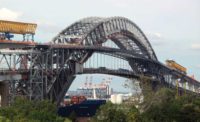The Utah Dept. of Transportation’s one-year-old Beaver Creek Bridge is located between the cities of Spanish Fork and Price. The scenic U.S. 6 mountain pass is “notorious for wildlife hits,” says UDOT Structural Designer Rebecca Nix. “The new bridge is an effort to reduce those accidents,” by providing a generous space under the bridge for wildlife to cross in addition to a creek crossing. Many safety projects, such as road widening, bridge replacement and other new crossings, have been completed on U.S. 6 in the last several years.
Besides improving safety, the bridge is also serving as a testing ground for new reinforcing material that could extend the life of concrete decks. Beaver Creek’s concrete deck panels use glass-fiber-reinforced polymer, or GFRP, bars instead of traditional steel rebar.
“The number one cause of degradation of bridges is rusting steel inside concrete,” says Fred Doehring, deputy structures engineer at UDOT. Bridges are designed to last 75 years or longer while decks only last 40 to 45 years. UDOT engineers hope to extend the life of bridges by using GFRP in concrete decks.
Building Beaver Creek Bridge
The bridge itself was built using accelerated bridge construction, which speeds up projects for the benefit of road users; precast concrete substructures were transported then assembled onsite. Beaver Creek’s deck consists of 24 precast deck panels on precast, prestressed girders with cast-in-place abutments. The deck panels are longitudinally post-tensioned using steel strands threaded through ducts, then secured and grouted.
The GFRP bars used in the concrete deck panels look similar to steel rebar. Since GFRP is much lighter than steel, the deck panels were relatively easy to transport and place. Tensile strength of the GFRP bars exceeds steel at 95,000 psi compared to steel at 60,000 psi. GFRP has lower elasticity, however, which means greater deflection over steel.
Design of the Beaver Creek Bridge deck accounts for that greater deflection; first, by increasing the number of GFRP bars over steel and second, by increasing the thickness of the deck. Two GFRP mats were placed in the top and bottom of each 9.25-in.-thick deck panel.
Since building bridges using GFRP is a relatively new technology, more information is needed about how the material functions under normal freeway traffic. UDOT is partnering with the Dept. of Civil and Environmental Engineering at the University of Utah to monitor the panels for two years to evaluate the suitability of GFRP for future use. U of U Prof. Chris Pantelides is heading the project, which focuses on long-term and short-term monitoring of the GFRP reinforced panels.
According to Pantelides, “GFRP rebar is seen as a breakthrough material expected to extend concrete life by a factor of four times due to its corrosion resistance.” Similar material used in 60-year-old boats shows that “no significant degradation in material strength can be detected.
“While most improvements in steel reinforcements incrementally improved the longevity of concrete structures—in applications where the concrete is exposed to heavy cyclic loads such as bridge decks, loading docks, railway crossings and driveways—fiberglass-reinforced concrete is expected to last 20 times longer than steel-reinforced concrete,” Pantelides says.
Testing, Testing…
Devices that measure stresses, temperature, lifting stresses and deflections were installed inside deck panels and on the bridge during construction. Two types of strain gauges were attached to GFRP bars in two bridge deck panels during precast. Electrical-resistance-strain gauges measure lifting stresses and deflections while vibrating-wire-strain gauges measure stresses and temperature inside bridge deck panels.
Position sensors were attached to the intermediate diaphragms that connect the deck to the girders. Six accelerometers were placed at the soffit of the girders to detect vertical acceleration. Data from the position sensors and accelerometers will be integrated to provide information about how heavy loads cause movement of bridge girders.
Monitoring of the deck panels using these devices began at the precast yard and continued during transport to the site and through post-tensioning “to investigate the presence of any cracks during handling and monitor the stress levels during lifting, transportation and initial stressing,” says Pantelides. “These are believed to be higher than the stresses that the decks will see in service.” The gauges will continue to monitor the panels for more than five years.
In addition, an onsite camera snaps a photo when sensors indicate the deck is stressed to a predefined trigger value. The photo is sent by a cell-phone connection to University of Utah researchers and is shared with UDOT.
The information gathered by UDOT and U of U will contribute significantly to future use of GFRP. U of U researchers are developing user-friendly software that will eventually be used by bridge inspectors. Nix is helping to evaluate the new information, and believes that by using GFRP data collected in a real-world setting, UDOT will eventually know how to “design based on what’s really happening.”





Post a comment to this article
Report Abusive Comment